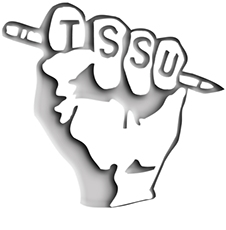
All TSSU members are welcome to attend General Membership meetings (GMs). Remember, you remain a member of TSSU for two semesters after your most recent TSSU appointment.
GMs take place three times every semester and a minimum of 20 members (quorum) must be present before any motions can be voted on. The membership has control of the Union resources and must approve the annual budget, financial statements, and any large expenditures. Committees and Executive members make regular reports at GMs, and are guided by the motions put forward at these meetings.
However, anything can be discussed at GMs. The business of the Union involves supporting efforts such as the advancement of organized labour and women’s equality at the University and in society at large, supporting social justice, anti-war campaigns at home and around the world, and donating money to environmental conservation funds.
What is the role of the Chair?
The Chair is responsible for conducting meetings in accordance with Bourinot’s Rules: maintaining a speakers list, ensuring there is quorum, following the rules of order. The Chair must be impartial during discussions, but casts the deciding vote if there is a tie.
What is quorum?
Twenty people are required to be present at a meeting in order to pass valid motions.
What happens first?
The Chair calls the meeting to order, and then the membership approves the agenda for the meeting and the minutes from the last meeting. Any members may ask to have items added to/removed from the agenda, and may make corrections to the last meeting's minutes.
How do I participate in the discussion?
Raise your hand. The Chair will put you on the speakers list and call on you when it is your turn.
How do I make a motion?
First, get on the speakers list. Then, when it is your turn to speak, say "Be it resolved that...", or "I move that..." and then describe your motion. It is helpful, but not necessary, to write it down first. Someone has to 'second' your motion before it is discussed. After the discussion, there is a vote. If you know before the meeting that you will be making a motion, you may forward it to the Executive at exec@tssu.ca if you wish to have it printed on the agenda.
What if I want to change the wording of the motion?
When it's your turn to speak, say "I move to amend the motion..." You may then propose to add, delete, or substitute words as long as you do not significantly alter the principle embodied in the original motion. Your amendment must be seconded. Once seconded, the Chair may ask the mover if the amendment is friendly. If the mover agrees, then the motion is immediately amended and debate continues. If the amendment is not considered friendly, then a debate on the amendment begins.
How do I end debate on a motion?
When it's your turn to speak, say "I move that the question be now put" ('put' means ending debate). If the Chair believes there has not been enough debate on the original motion, they may disallow your motion to put the question. If the Chair believes there has been sufficient debate, your motion that the question be put is voted on. If your motion to put the question passes, then the original motion goes immediately to a vote. If your motion fails, then debate on the original motion continues. Finally, if everyone on the speakers list has spoken, the chair may call the question.
What if I think the rules of order are being broken?
You may choose to raise your hand and say "Point of order." The chair will ask the current speaker to pause and allow you to state your case for the point of order. The Chair will rule on your point of order and the meeting will proceed.
How does a motion win, or 'carry'?
For a motion to carry, it requires a simple majority vote (i.e. more than half). Amendments to the By-Laws require a two-thirds majority.
John Bourinot, Clerk of Canada's House of Commons from 1880-1902, wrote these rules of order and very little has needed to be updated over the years. These rules were designed for the Canadian Parliament rather than for organizations and associations such as unions. Parliamentary procedure may sound threatening, but it has simply become a standard for conducting business at a meeting.
These rules are also used to conduct meetings that span days or weeks, and not just hours. Thus, many of the more complicated terminology and motions are not used by the TSSU.
Because of the origins of the rules, and because many words and phrases are no longer used, it is common to be confused. TSSU wants to demystify the process of conducting its meetings, so if you do not know what is happening, or why, please raise your hand and ask for clarification (known as a “point of information”) and the chair will do their best to explain.
